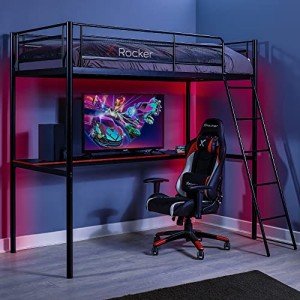Understanding UK Bunk Beds: A Comprehensive Guide
Bunk beds have actually become a popular choice for numerous households across the United Kingdom. They provide an efficient service for saving space, accommodating several sleepers, and adding an element of enjoyable to a child's room. With various designs, products, and safety functions available, selecting the best bunk bed can be daunting. This short article intends to provide an in-depth look into UK bunk beds, covering their types, advantages, safety standards, and purchasing pointers.
The Types of Bunk Beds
When it comes to bunk beds, the choices are virtually limitless. The main categories consist of:
1. Requirement Bunk Beds
These are the classic design, featuring two beds stacked one on top of the other. Standard bunk beds are perfect for brother or sisters sharing a space or sleepovers.
2. Loft Beds
Loft beds rise beds without a lower bunk. This design offers ample space below for a research study location, extra storage, or play space for children.
3. L-Shaped Bunk Beds
These beds have an L-shape design, enabling them to suit corners or odd spaces in a room. They are frequently ideal for larger rooms and provide versatility in sleeping arrangements.
4. Triple Bunk Beds
Created for bigger households, triple bunk beds accommodate 3 sleeping spaces. These beds provide vertical sleeping plans and can be an exceptional choice for optimizing room capacity.
5. Futon Bunk Beds
These flexible beds combine a standard upper bunk with a futon or couch below. This style can be used for sleeping or seating, making it a multifunctional choice for smaller sized spaces.
6. Bunk Beds with Storage
Some contemporary bunk beds come geared up with drawers or shelving, supplying extra storage space for clothes, toys, or books. This feature is especially useful in spaces that require arranged storage services.
Advantages of Bunk Beds
Bunk beds use many benefits, making them a desirable option for many homes:
- Space-Saving: Bunk beds make use of vertical space, permitting for more open floor location in smaller sized rooms.
- Cost: Sharing a space and purchasing one bunk bed can be more cost-effective than buying different beds for several kids.
- Enjoyable Factor: Bunk beds offer a sense of adventure and excitement, especially for kids, making bedtime more pleasurable.
- Versatile Layouts: With various styles offered, bunk beds can fit any room design, guaranteeing style and performance.
- Storage Options: Many designs integrate additional storage options, assisting to keep spaces tidy.
| Benefits of Bunk Beds | Description |
|---|---|
| Space-Saving | Utilizes vertical space to free up floor area. |
| Cost | More affordable for families with multiple kids. |
| Fun Factor | Adds enjoyment to bedtime and promotes imaginative play. |
| Versatile Layouts | Mixes can fit numerous room configurations. |
| Storage Options | Built-in drawers and shelves help keep items organized. |
Safety Standards
When choosing bunk beds, security needs to be a leading priority, especially for kids. click the following website has developed regulations to guarantee that bunk beds meet specific security requirements. For example:
- Guardrails: Beds should have guardrails on both sides of the leading bunk to prevent unintentional falls.
- Mattress Size: Beds must work with a correct bed mattress size to ensure safe use. The bed mattress needs to not surpass the top of the guardrails.
- Strong Construction: Bunk beds should be made from durable products to endure regular use, ensuring stability and longevity.
- Weight Limit: Every bunk bed has a weight limit which must be complied with for security reasons.
- Assembly Instructions: Proper assembly is important; follow the producer's standards closely to ensure structural stability.
Buying Tips
When set to buy a bunk bed, consider the following points:
- Room Size: Measure the room dimensions to make sure the chosen bed fits comfortably.
- Height Consideration: Ensure there suffices space above the leading bunk to prevent bumps on the ceiling.
- Material Choice: Look for durable products with a quality finish. Wood and metal are popular options, with each providing various aesthetic appeals and toughness.
- Security Features: Verify that the bed satisfies security requirements and has sufficient guardrails and a tough ladder.
- Design Compatibility: Select a style that matches the existing decor of the space.
- Budget plan: Set a spending plan before exploring your alternatives, as bunk beds can span a large rate range.
Regularly Asked Questions (FAQs)
1. What age is appropriate for a top bunk?
Usually, children aged six and older can sleep on the leading bunk, but constantly examine particular producer standards for age recommendations.
2. How do I preserve my bunk bed?
Regularly examine for any loose screws or parts, clean the bed periodically, and guarantee it stays steady.
3. Can bunk beds accommodate adults?
While some bunk beds are created for much heavier weights, the majority are primarily meant for children. Examine the weight restricts if thinking about adult use.
4. Are bunk beds simple to assemble?
The majority of bunk beds come with in-depth assembly guidelines and all required tools. Nevertheless, some designs may need professional assembly.
5. Can I utilize a thicker bed mattress on a bunk bed?
It is essential to follow the manufacturer's guidelines concerning bed mattress density to make sure security and compliance with the guardrails.
Bunk beds are a versatile and practical choice for households wanting to maximize space and create a fun sleeping environment for their kids. With a myriad of designs offered, it's important to consider the specific needs of the home while prioritizing security and convenience. By understanding the different types, advantages, and crucial considerations surrounding bunk beds, moms and dads can make educated decisions that will boost their kids's living areas.

